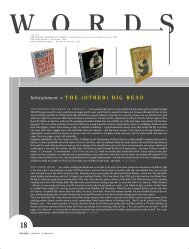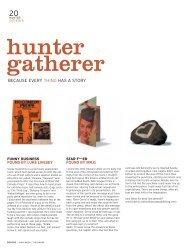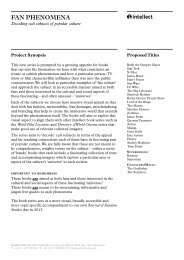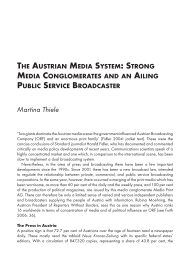Anthem - Intellect
Anthem - Intellect
Anthem - Intellect
You also want an ePaper? Increase the reach of your titles
YUMPU automatically turns print PDFs into web optimized ePapers that Google loves.
<strong>Anthem</strong><br />
of fact. Cook hears the lyrics expressing a belief in ‘the existence of a loving Father<br />
above the stars’, set to music in ‘a remote, hieratic style’ that evokes ecclesiastical chant,<br />
sounding like ‘a series of daydreams’, where the repeated notes in bars 647–54 ‘are<br />
surely meant to depict the twinkling of the stars, it is as if time stood still’. 376<br />
E. Bar 655–762. This section opens with a D-major double fugue based on the ‘Joy’<br />
and ‘Seid umschlungen’ themes, thus mixing lyrics from Verse 1 and Chorus 3, ending<br />
with the ‘Ihr stürzt nieder’ episode of Chorus 3 and finally the Chorus 1 lyrics, so that<br />
the symphony ends with repeating the frantic ecstacy of joy. Cook sees this double fugue<br />
as representing ‘a reawakening, a return to reality’, with a concluding, integrating and<br />
recapitulatory function but also serving as a transition to the next series of codas. 377<br />
F. Bar 763–940. D-major ending starts with Verse 1 lyrics sang to coda figure 1<br />
based on the ‘Joy’ theme, followed by a cadenza and then coda figure 2 with Chorus<br />
1 followed by Verse 1 lyrics, and finally coda figure 3 again based on the ‘Joy’ theme<br />
ends the work. These coda sections sound like a rather traditional operatic finale. The<br />
words ‘Alle Menschen werden Brüder’ are strongly emphasised, until in the final bars<br />
920ff. everything is united in ecstatic harmony: choir and soloists, strings and wind<br />
instruments, solemn and military sounds—all joyfully united in diversity! 378<br />
Commentators such as Romain Rolland have described the Ninth Symphony’s<br />
finale as a climactic victory over deep misery: a joy of struggle transformed into<br />
transcendental ecstacy and finally a veritable ‘delirium of love’. 379 Cook describes in<br />
detail how subsequent listeners have interpreted Beethoven’s symphony differently,<br />
according to their own agendas. For instance, Wagner chose to read the baritone’s<br />
words ‘not these tones’ (‘nicht diese Töne’) as referring ‘to the horror fanfare, to the<br />
first three movements, ultimately to instrumental music as a whole’, so that musical<br />
time is transformed into ‘dramatic or ritualistic time’, and ‘what began as a musical<br />
event turns at this point into a social one’. 380<br />
Cook also shows that even quite recent twentieth century critics have generally been<br />
disturbed by the heterogeneity of the work, in particular having great problems with<br />
‘the most outrageously foreign element’ of the ‘Turkish’ music in bar 331ff., finding it<br />
‘almost perverse’ that Beethoven combined this music—with both military and popular<br />
associations—with lyrics speaking of God’s angels in the sky. 381 In this frustration, Cook<br />
recognises a dominant Romantic strategy of ‘creating meaning out of incoherence’ that<br />
tends to domesticate Beethoven’s music, reducing its excess of meaning. 382<br />
Romantic interpretations reduce the contradictory elements of the<br />
Ninth Symphony to a narrative thread or a series of pictures; absolutemusic<br />
interpretations reduce them to an architectural plan. And the<br />
result in each case is the same: the music is deproblematized, sanitized,<br />
shrink-wrapped. 383<br />
167












